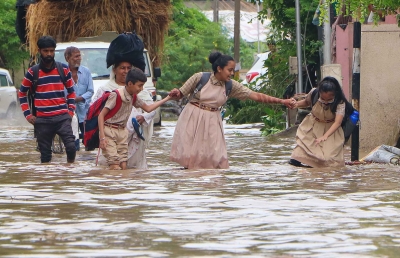How experts view Gujarat's civic woes exposed by recent rain havoc
By IANS | Published: July 17, 2022 10:21 AM2022-07-17T10:21:03+5:302022-07-17T10:35:07+5:30
Gandhinagar, July 17 In three hours Ahmedabad received 125 mm rain on July 10, and faced water-logging, Rajkot ...

How experts view Gujarat's civic woes exposed by recent rain havoc
Gandhinagar, July 17 In three hours Ahmedabad received 125 mm rain on July 10, and faced water-logging, Rajkot received 133 mm in 24 hours, yet the roads were still flooded on July 11. The same was the story of Surat, Vadodara and other cities in Gujarat. This is because urban planning for storm water is based on historical data and not on projected data, climate change is not considered while planning, is what the experts say.
When one listens to the officers or the elected representatives, they prove the experts right. Take the example of Ahmedabad, the Municipal Corporation Water Committee chairman Jatin Patel said, "The city has 980 kilometres storm water pipeline, its capacity is to carry one inch of rain in an hour, if it rains more water- logging will happen."
Patel does not have information whether this facility was ever upgraded, but now he is going to discuss this with the executive wing for enhancement of the capacity.
In another major city Vadodara, the municipal corporation website says in 2012 the stormwater network was 108 square kms, redesigned and maintained natural drains of 33 kms, for a city spread over 158 square kms with a population of 16 lakh in 2011.
City executive engineer Rajesh Shimpi did not answer queries whether this capacity was expanded or not in the last 10 years.
Again, Saurashtra's financial capital Rajkot's present stormwater capacity is not enough for its requirements. The city's west zone deputy engineer K S Gohil said, "based on other colleagues' experience, where it rains heavily and where less, a pipeline with 1400 mm to 300 mm diameter is installed. Our aim is to bring down the water-logging time, there can't be a 100 percent solution. Earlier water used to stagnate for one and a half hours, but that has been reduced to 40 to 45 minutes."
According to Devang Parekh, Dean of Indubhai Parekh School of Architecture, Rajkot, the water-logging for hours and sometimes for a day or two in the cities can be attributed to two reasons firstly, very heavy rain and secondly, poor planning.
Former chief town planner of the state Paresh Sharma said historical data on rainfall is used for future projections and planning and this old method needs to be replaced with projection based planning, considering climate change and monsoon patterns. The rainy days have reduced but the intensity has increased, so infrastructure should be designed to meet these erratic rain patterns in the coming years, suggested Sharma.
For decades climate change has been talked about and even budgets have been allocated, but no one is serious, felt Mahesh Pandya, an environmentalist. Citing a recent example, he said on June 7 the Ahmedabad Municipal Corporation held a public consultation event to plan how to use a Rs 3000 crore World Bank loan to create stormwater and drainage facilities. But no brainstorming happenned, only the Mayor, Deputy Mayor and Commissioner were felicitated.
Sharma and Parekh are of the view that as population growth is estimated, similarly rainfall should be estimated for the next five to ten years. Based on such estimates the drainage/stormwater pipeline size and even cement ducks can be planned and designed that can clear rainfall of 4 or 5 inches in an hour.
Disclaimer: This post has been auto-published from an agency feed without any modifications to the text and has not been reviewed by an editor
Open in app